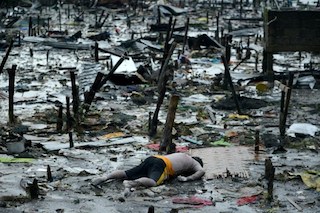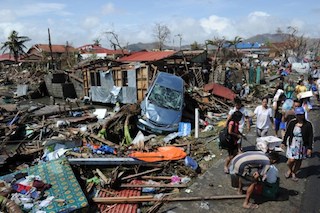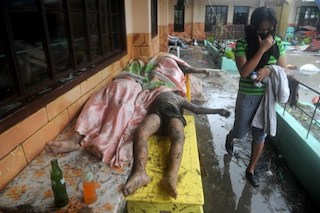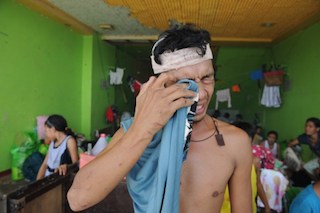10th November, 2013
. whole towns destroyed and thousands perish
TACLOBAN, (AFP) – The death toll from a super typhoon that decimated entire towns in the Philippines could soar well over 10,000, authorities warned Sunday, making it the country’s worst recorded natural disaster.
The horrifying estimates came as rescue workers appeared overwhelmed in their efforts to help countless survivors of Super Typhoon Haiyan, which sent tsunami-like waves and merciless winds rampaging across a huge chunk of the archipelago on Friday.
Hundreds of police and soldiers were deployed to contain looters in Tacloban, the devastated provincial capital of Leyte, while the United States announced it had responded to a Philippine government appeal and was sending military help.
“Tacloban is totally destroyed. Some people are losing their minds from hunger or from losing their families,” high school teacher Andrew Pomeda, 36, told AFP, as he warned of the increasing desperation of survivors.
“People are becoming violent. They are looting business establishments, the malls, just to find food, rice and milk… I am afraid that in one week, people will be killing from hunger.”
Authorities were struggling to even understand the sheer magnitude of the disaster, let alone react to it, with the regional police chief for Leyte saying 10,000 people were believed to have died in that province alone.
“We had a meeting last night with the governor and, based on the government’s estimates, initially there are 10,000 casualties (dead),” Chief Superintendent Elmer Soria told reporters in Tacloban.
“About 70 to 80 percent of the houses and structures along the typhoon’s path were destroyed.”
On the neighbouring island of Samar, a local disaster chief said 300 people were killed in the small town of Basey.
He added another 2,000 were missing there and elsewhere on Samar, which was one of the first areas to be hit when Haiyan swept in from the Pacific Ocean with maximum sustained winds of 315 kilometres (195 miles) an hour.
Dozens more people were confirmed killed in other flattened towns and cities across a 600-kilometre stretch of islands through the central Philippines.



Deadliest natural disaster
The Philippines endures a seemingly never-ending pattern of deadly typhoons, earthquakes, volcano eruptions and other natural disasters.
This is because it is located along a typhoon belt and the so-called Ring of Fire, a vast Pacific Ocean region where many of Earth’s earthquakes and volcanic eruptions occur.
However, if the feared death toll of above 10,000 is correct, Haiyan would be the deadliest natural disaster ever recorded in the country.
The previous deadliest disaster in the Philippines occurred in 1976, when a tsunami triggered by a magnitude 7.9 earthquake devastated the Moro Gulf on the southern island of Mindanao, killing between 5,000 and 8,000 people.
Haiyan’s maximum sustained wind speeds made it the strongest typhoon in the world this year, and one of the most powerful ever recorded.
Witnesses in Tacloban recalled waves up to five metres (16 feet) high surging inland, while aerial photos showed entire neighbourhoods destroyed with trees and buildings flattened by storm surge.
“The huge waves came again and again, flushing us out on the street and washing away our homes,” Mirasol Saoyi, 27, told AFP near Tacloban’s seaside sports stadium, where thousands of people had gathered after it withstood the typhoon.
“My husband tied us together, but still we got separated among the debris. I saw many people drowning, screaming and going under… I haven’t found my husband.”
The Philippine country director of the World Food Programme, Praveen Agrawal, who visited Tacloban, said the devastation resembled that from a tsunami, rather than a typhoon.
“All the trees are bent over, the bark has been stripped off, the houses have been damaged. In many cases they have collapsed,” he told AFP.
President Benigno Aquino said while visiting Tacloban that looting had emerged as a major concern, after only 20 officers out of the city’s 390-strong police force turned up for work following the typhoon.
“So we will send about 300 police and soldiers to take their place and bring back peace and order,” he told reporters in Tacloban.
“Tonight, an armoured vehicle will arrive and our armed forces will display the strength of the state to put a stop to this looting.”
As the scale of the disaster began to emerge, an international aid effort began to ratchet up.
In Washington, the Pentagon announced that US Defence Secretary Chuck Hagel had responded to a request from the Philippines for military aid and directed the US Pacific Command to deploy resources.
United Nations leader Ban Ki-moon also promised that UN humanitarian agencies would “respond rapidly to help people in need”, while the European Commission said it would give three million euros ($4 million) to help in relief efforts.
British Prime Minister David Cameron called Aquino to extend his sympathy, and offered an emergency support package worth six million pounds ($9.6 million).

Haiyan moved out of the Philippines and into the South China Sea on Saturday, from where it tracked towards Vietnam.
Although it weakened out at sea, more than 600,000 people were evacuated in Vietnam ahead of its expected landfall on Monday morning.
The impacts of the storm were also felt further north, with six members of a cargo boat missing off the southern Chinese island province of Hainan, state media in China reported.


